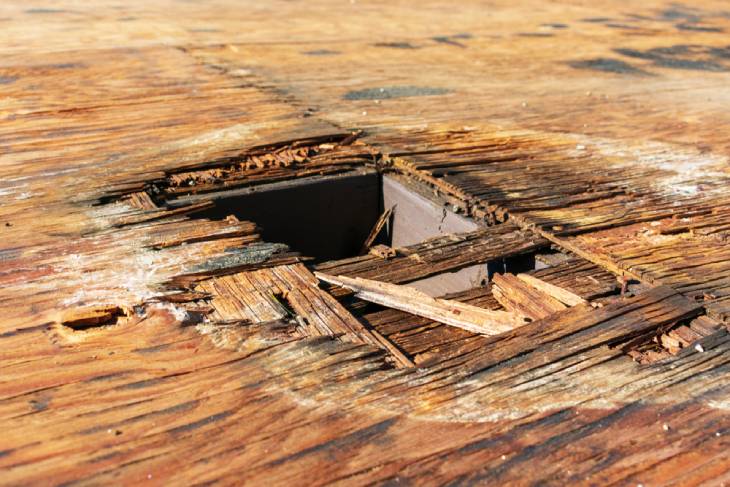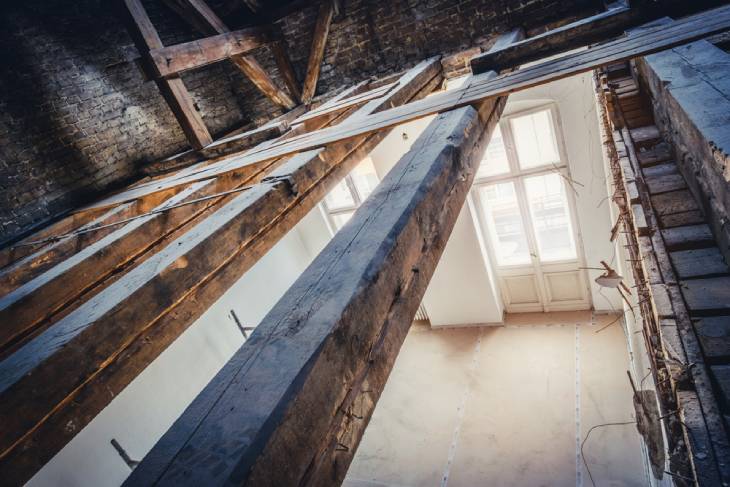
Wooden floors have a timeless beauty, but they are quite vulnerable to water. Even a small amount of standing water can start the warping process and alter the smooth, flat surface of your wood floors. If your home or basement has been flooded, you need to address the issue within the first 24 hours to prevent irreversible, permanent damage.
How to Identify Water Damage in Wooden Flooring?
Is the floor damp? Can you feel or see excess moisture content on its surface? Maybe when you walk across the room, you notice water oozing out from where the planks meet. This could indicate water damage. Here are some additional signs that suggest more serious hardwood floor water damage:
- Spots that have turned darker or look stained
- Wood planks that look bent or twisted out of shape
- The protective layer on top might show blisters or look like it is peeling off
- Planks not sitting right anymore; they could be loose or feel wobbly underfoot
- Boards lifting away from the entire floor beneath them
- Squeaking or sections shifting under your weight
- The edges of the organic material boards curving upwards or showing waves
- If you have engineered wood flooring, the layers separating — a process known as delaminating
- If you use a moisture meter to measure how much moisture is in the wood, high readings can confirm your suspicions
These are clear indicators that excess water has made its way into the surface and may damage hardwood floors.

How Long Does it Take for Water to Damage Wood Floors?
If you are looking at a spill or leak, knowing how fast you need to act can save you a lot of money in expensive repairs and possibly protect you from mold growth-related health issues.
Within a few minutes of a spill, water starts to seep into the cracks and crevices of wood floors. This does not mean your floors will be ruined right away, but the top layer will start to absorb water. Prefinished wood floors might offer a bit of resistance due to their coating, but unfinished or natural wood will absorb water quickly. Initially, you might notice a darkening of the wood where the water is absorbed.
Within the next 24 hours, water will penetrate deeper into the wood. The wood may start to swell more noticeably, especially at the edges. If water remains for 24 to 48 hours or if the wood is excessively exposed, you will start to see more pronounced swelling, warping, or cupping. Cupping is where the edges of the planks rise higher than their centers. Staining can become more apparent, and the finish might begin to peel or flake off as the wood underneath expands.
Timely action matters. If you manage to dry out the water-damaged hardwood floors within the first 24 hours, you might escape with minimal damage. Use towels to soak up the water, and if possible, employ fans and dehumidifiers to speed up the drying process. Avoid heat, as it can cause more warping.
Continued exposure or retention of moisture over the next two to four days exacerbates further damage. Planks may begin to buckle, which is a more severe form of warping where the boards lift off the subfloor. Mold and mildew might start to develop in less visible areas like under the planks.
If the water sits for more than 72 hours, at this point, the wood has likely undergone major structural changes. The integrity of the wood might be compromised, with cracking or splitting becoming evident. Mold and mildew growth could be widespread, for which you will need professional assistance.
It’s critical to get an expert evaluation if water has been standing for more than a day. The GotRot specialists can determine the extent of the damage, including to the subfloor, and suggest whether refinishing or replacement is necessary. Remember, all water-damaged hardwood floors react differently depending on the type of wood, the finish, and how it was installed.
Steps You Can Take to Repair Minor Water-Damaged Wood Floors
If you have caught the damage to your hardwood flooring within a day, the following tips may help you mitigate the effects yourself:
- Use clean, absorbent towels or cloths to blot up as much water as possible from the surface of the wood. Press down firmly to absorb water but avoid rubbing to prevent spreading the moisture further.
- If available, a wet-dry vacuum can be highly effective in removing water from the water-damaged wood floor surface, as well as cracks and crevices, quickly and efficiently.
- Open windows and doors to improve air circulation in the affected area. If the weather is humid, keep windows closed and rely on indoor fans.
- Position fans to blow directly onto the affected area. If you have ceiling fans, turn them on to help circulate air throughout the room.
- Place a dehumidifier in the room to draw moisture out of the air and the wood. Keep it running for at least 24 hours or until the floor feels dry to the touch.
- Keep the room at a moderate temperature, ideally between 60 to 75 degrees Fahrenheit, with humidity levels between 30% to 50% to facilitate optimal drying.
- Once the floor is dry to the touch, check for signs of cupping or warping. Some minor warping can rectify itself as the wood dries completely, which can take days or weeks.
- Direct heat can cause the wood to warp further, so avoid using heat guns or hair dryers.
Choose the Specialists to Protect Against Water Damage to Your Wood Floors
Water-damaged wood flooring could mean a significant loss of investment. Moreover, clearing all that water and moisture by yourself may not only be time-consuming but could also be hazardous if you do not have the proper skills or tools. When you realize there is a flood on your hands, contact the experts at GotRot for wood floor water damage restoration. If you are in the Washington area, call us at 206-312-5168 or contact us online to schedule a visit.